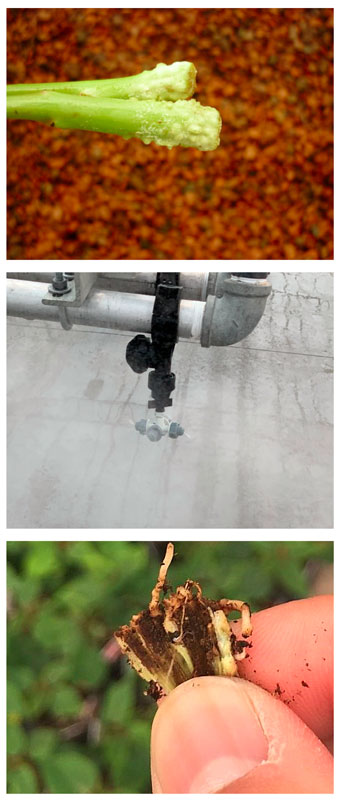5/1/2023
Poinsettia Propagation
Gary Vollmer
 Figure 1. Dipping poinsettia cuttings into a liquid formulation is preferred. Make sure to dip at least ¾ of an inch up the stem on the base of the cutting.
Figure 1. Dipping poinsettia cuttings into a liquid formulation is preferred. Make sure to dip at least ¾ of an inch up the stem on the base of the cutting.
Figure 2. Using fog-type nozzles helps to maintain higher humidity and less free water on the cutting and media, which improves rooting.
Figure 3. Fungus gnat larvae feed on poinsettia stems and roots.
The first and critical step in producing a quality poinsettia is to get the cutting rooted. Poinsettias are a tender leafy cutting that’s propagated during the heat of summer. This makes poinsettia propagation specifically challenging.
Creating a sanitary environment in which to propagate poinsettia is critical. All surfaces involved in cutting handling and rooting must be sanitized prior to cutting arrival. Consistent use of hand sanitation and foot baths will help to maintain cleanliness throughout the process. Quaternary ammonium-based disinfectants are most commonly used, but peroxide and chlorine-based disinfectants can be used.
Upon receiving the unrooted cuttings, the boxes need to be opened immediately to allow accumulated ethylene gas to escape. Checking the temperature will determine if the cuttings heated up during shipment. The cuttings should be between 50 to 60F (10 to 16C). If they arrive warmer, it’s highly recommended that the opened boxes should be stored in a cooler at 50F (10C) for at least four hours and can be stored overnight. If the shipment of cuttings cannot all be stuck within a couple of hours after arrival, they need to be stored in a cooler ideally, but in a cool place regardless.
Using a rooting hormone is highly recommended. Dipping rates from 1,000 to 1,500 ppm IBA are commonly used. Dipping the cutting into a liquid formulation is preferred, making sure to dip at least ¾ of an inch up the stem on the base of the cutting (Figure 1). Post-stick sprays of 200 to 300 ppm IBA can be used as well, but some stem callus and leaf twisting may occur.
When choosing a rooting media for liner propagation, a form of a stabilized product like an Ellepot or Oasis wedge is preferred. As a poinsettia has a thick and moderately branched root system, loose-fill media often leads to soil dropping out and root damage at transplanting. Ideally, a poinsettia liner is rooted for four weeks. With this shorter crop time, waiting for the loose-fill liner to root out may take too long. In direct sticking, it’s imperative that the media be very well drained to prevent fungus gnat and Pythium attacks during the rooting phase.
To root a poinsettia, a high humidity shaded propagation area is required. If excess mist is applied, bad things happen—fungus gnats, Botrytis, Pythium and other disease become problems. Too much mist will result in significantly delayed rooting. The tell-tale sign of excess mist is a large ball of callus forming on the base of the cutting with little or no roots. Over-misting is the most common mistake in poinsettia propagation.
Temperatures of 72 to 77F (22 to 25C) are ideal. Temps below 68F (20C) can slow rooting. Higher temperatures result in stress and can force excessive misting to prevent wilting. Maintain humidity of 80% or higher in the rooting area. Using fog-type nozzles helps to maintain higher humidity and less free water on the cutting and media, improving rooting (Figure 2). Mist levels must be reduced after five to seven days to force the roots to form after the callusing. The cuttings should be fully off mist by about day 14.
Common disease challenges in poinsettia propagation are Erwinia and Botrytis. Erwinia occurs very early in the process; it’s usually run its course within a few days after stick. Sanitation and reducing lateral splashing will help reduce the disease. Botrytis can occur on the damaged tissue that’s caused by ethylene damage in the cutting. Preventative fungicide sprays can be effective once mist levels are reduced.
The most serious insect problem during propagation is fungus gnats. The larvae feed on poinsettia stems and roots (Figure 3). This causes damage and creates opportunities for Pythium to attack on the damaged tissue anytime during the production cycle. Sanitation, insecticides and nematodes are effective tools for fungus gnat control. GT
Gary Vollmer is the global product manager for Selecta One North America and the company’s main technical support expert. Find his plant culture tips and guidelines online at selectanorthamerica.com.